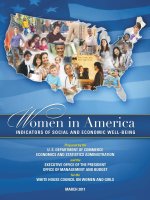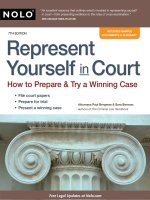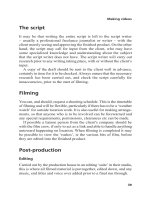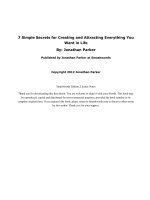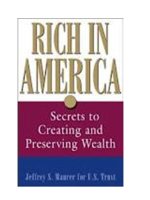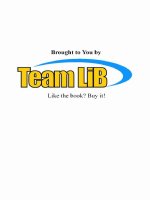Rich in America - Secrets to Creating and Preserving Wealth doc
Bạn đang xem bản rút gọn của tài liệu. Xem và tải ngay bản đầy đủ của tài liệu tại đây (2.07 MB, 288 trang )
Rich in America
00 FM Maurer 6/20/03 4:55 PM Page i
00 FM Maurer 6/20/03 4:55 PM Page ii
Rich in America
Secrets to Creating
and Preserving Wealth
Jeffrey S. Maurer
for U.S. Trust
John Wiley & Sons, Inc.
00 FM Maurer 6/20/03 4:55 PM Page iii
Copyright © 2003 by United States Trust Company of New York. All rights reserved.
Published by John Wiley & Sons, Inc., Hoboken, New Jersey.
Published simultaneously in Canada.
No part of the publication may be reproduced, stored in a retrieval system, or trans-
mitted in any form or by any means, electronic, mechanical, photocopying, recording,
scanning, or otherwise, except as permitted under Section 107 or 108 of the 1976
United States Copyright Act, without either the prior written permission of the
Publisher, or authorization through payment of the appropriate per-copy fee to the
Copyright Clearance Center, Inc., 222 Rosewood Drive, Danvers, MA 01923, 978-
750-8400, fax 978-750-4470, or on the web at www.copyright.com. Requests to the
Publisher for permission should be addressed to the Permissions Department, John
Wiley & Sons, Inc., 111 River Street, Hoboken, NJ 07030, 201-748-6011, fax 201-
748-6008, e-mail:
Limit of Liability/Disclaimer of Warranty: While the publisher and author have used
their best efforts in preparing this book, they make no representations or warranties
with respect to the accuracy or completeness of the contents of this book and specifi-
cally disclaim any implied warranties of merchantability or fitness for a particular pur-
pose. No warranty may be created or extended by sales representatives or written sales
materials. The advice and strategies contained herein may not be suitable for your sit-
uation. You should consult with a professional where appropriate. Neither the pub-
lisher nor author shall be liable for any loss of profit or any other commercial damages,
including but not limited to special, incidental, consequential, or other damages.
For general information on our other products and services, or technical support,
please contact our Customer Care Department within the United States at 800-762-
2974, outside the United States at 317-572-3993 or fax 317-572-4002.
Wiley also publishes its books in a variety of electronic formats. Some content that
appears in print may not be available in electronic books.
For additional information about Wiley products, visit our web site at www.wiley.com.
Library of Congress Cataloging-in-Publication Data:
Maurer, Jeffrey S.
Rich in America : secrets to creating and preserving wealth / Jeffrey S. Maurer.
p. cm.
Published simultaneously in Canada.
ISBN: 0-471-44548-7 (cloth)
1. Finance, Personal—United States. 2. Investments. 3. United States Trust
Company of New York. I. Title.
HG179.M354 2003
332.024Ј01—dc21
2003011339
Printed in the United States of America
10987654321
00 FM Maurer 6/20/03 4:55 PM Page iv
To my wife Wendy,
for her love, support, and
encouragement—and for sharing me with
U.S. Trust, its staff, and its clients for 33 years.
00 FM Maurer 6/20/03 4:55 PM Page v
00 FM Maurer 6/20/03 4:55 PM Page vi
vii
ACKNOWLEDGMENTS . . . . . . . . . . . . . . . . . . . . . . . . . . . . . . . . . ix
P
REFACE . . . . . . . . . . . . . . . . . . . . . . . . . . . . . . . . . . . . . . . . . . xi
I
NTRODUCTION . . . . . . . . . . . . . . . . . . . . . . . . . . . . . . . . . . . . . . . 1
C
HAPTER 1 . . . . . . . . . . . . . . . . . . . . . . . . . . . . . . . . . . . . . . . . . 19
Financial Planning
CHAPTER 2 . . . . . . . . . . . . . . . . . . . . . . . . . . . . . . . . . . . . . . . . . 43
Investments
CHAPTER 3 . . . . . . . . . . . . . . . . . . . . . . . . . . . . . . . . . . . . . . . . 103
Taxes
CHAPTER 4 . . . . . . . . . . . . . . . . . . . . . . . . . . . . . . . . . . . . . . . . 139
Insurance
CHAPTER 5 . . . . . . . . . . . . . . . . . . . . . . . . . . . . . . . . . . . . . . . . 161
Retirement
CHAPTER 6 . . . . . . . . . . . . . . . . . . . . . . . . . . . . . . . . . . . . . . . . 187
Estate Planning
CHAPTER 7 . . . . . . . . . . . . . . . . . . . . . . . . . . . . . . . . . . . . . . . . 217
How to Choose a Financial Advisor
CONCLUSION. . . . . . . . . . . . . . . . . . . . . . . . . . . . . . . . . . . . . . . 239
A
PPENDIX . . . . . . . . . . . . . . . . . . . . . . . . . . . . . . . . . . . . . . . . . 247
Examples of Financial Planning Schedules
INDEX . . . . . . . . . . . . . . . . . . . . . . . . . . . . . . . . . . . . . . . . . . . . 259
Contents
00 FM Maurer 6/20/03 4:55 PM Page vii
00 FM Maurer 6/20/03 4:55 PM Page viii
ix
W
riting a book may sound like a solitary occupation, but the
truth is that without the help of countless people, this
book could never have been finished.
Most of all, I would like to thank the current and former staff of
U.S. Trust for their remarkable professionalism and talent. Without
them, there wouldn't be a U.S. Trust, nor a book.
There are a few people who deserve special mention for their
superb support and guidance: John Apruzzese, Drew Bender, Matt
Canner, Leslie Draper, Mitchell Drossman, Linda Franciscovich, Nancy
Gabel, Daina Hill, Stephen Kao, Steve Lavner, Lynn Lederman,
Geraldine McNamara, Lee Paula Miller,Teresa Periera, Ralph Rittenour,
Donna Romer, Ray Russolillo, Kathy Segal, Fraser Seitel, Fred Taylor,
and Chris Zander. I am very grateful to each and everyone of the
above. Thank you.
Also helpful were: Gene Bernstein, Gerald Calder, Kevin Casey,
Gavin Cuneo, Marti Dinerstein, Kathleen Donohue, Tom Evnin, Dick
Foley, Gary Gildersleeve, John Gregg, Kathy Kamerer, Lori Jackson,
Robert MacDonnell, Lisa Marcus, Paul Napoli, Robin Petty, Susan
Porter, Paul Sawina, Carol Strickland, Bob Stolar, Bruce Tavel, Barry
Waldorf, and Sean White.
Acknowledgments
00 FM Maurer 6/20/03 4:55 PM Page ix
I would also like to thank Jeanne Glasser, my editor at John Wiley,
for her steadfast commitment to the project, as well as my agent,
Andrew Wylie. In addition, I am grateful to Gene Stone, who was able
to grasp the complexities of wealth management at U.S. Trust and turn
my experiences, ideas and advice into enlightening and entertaining
prose.
Finally, I must give a special thank you to Allison Kellogg. Allison
was there at the beginning of this project, she was there whenever
extra work needed to be done, and she was there to make sure the
project came to a successful conclusion. I can't thank her enough, nor
the supportive and skillful people on her staff, including Kathleen
McGraw, Heather Fontaine and Bill Rigler.
x Acknowledgments
00 FM Maurer 6/20/03 4:55 PM Page x
xi
F
or 150 years, U.S. Trust has been one of the world’s leading
experts on the affluent and their money. I am proud to have
worked at this organization—now the world’s oldest trust company—
for more than 30 years, and to have absorbed a great deal of the knowl-
edge such a venerable institution can impart.
U.S. Trust was founded in 1853 by a group of financial pioneers
who raised $1 million to create an innovative financial institution
chartered as the United States Trust Company of New York. It was
established to serve as manager, executor, and trustee of personal and
corporate funds. At that time this was an original and innovative idea.
Trust functions, if they existed at all, were performed by individuals,
not by institutions. Among our founders were entrepreneurs and
industrialists such as Peter Cooper, Erastus Corning, and Marshall
Field. Our earliest clients were also entrepreneurs and industrialists—
railroad barons, merchants, shipbuilders—and the large corporations
that they created.
The firm’s impressive history has meant that many of the most
prominent and wealthy businessmen of their times served on our board
and often became clients. The roster of these board members included
three generations of Astors ( John Jacob, Vincent, and William Waldorf),
Preface
00 FM Maurer 6/20/03 4:55 PM Page xi
William Dodge, John Phelps, William Rockefeller, and John Hay
Whitney and Payne Whitney. However, it took time for the idea
behind U.S.Trust to catch on. In the mid- to late 1800s, most affluent
Americans held their assets in local real estate or business ventures.
Cash holdings were not abundant, and there was little opportunity
to invest in stocks, because few business were publicly held. But
U.S. Trust managed to flourish by offering personal banking, includ-
ing commercial and personal loans, and by purchasing mortgages and
other investments.
At the turn of the twentieth century, given the rise of large
corporations, the transfer of wealth to a new generation, industriali-
zation, and the establishment of the income tax, the economic climate
U.S. Trust had envisioned 50 years earlier became a reality, and it was
well situated to handle the country’s changing economic needs. By
1928, U.S. Trust’s seventy-fifth anniversary, our trusteed assets totaled
over $1 billion, far exceeding those of any other trust institution.
Eventually, the company expanded from its New York roots to open
offices in 12 states and the District of Columbia. We acquired other
companies and added new services, and divested parts of the business
to continue our focus on wealth management. Today, U.S. Trust holds
managed investment assets of more than $75 billion, while its total
assets under management top $90 billion. Including personal custody
assets and clients’ deposits, the firm’s total client assets amount to
almost $125 billion.
U.S. Trust has continuously prospered despite the various upturns
and downturns in the nation’s fortunes. In fact, the year I arrived at the
company, 1970, was one of the most difficult this country has ever
faced. In the spring of that year, Richard Nixon, recently sworn in as
the nation’s thirty-seventh president, was overseeing the turmoil caused
by the Vietnam war. Virtually every American college campus was
rocked by student protest, and the nation’s urban areas were seething
with discontent. On May 4, 1970, shortly after Nixon had ordered the
xii Preface
00 FM Maurer 6/20/03 4:55 PM Page xii
invasion of Cambodia, the Ohio National Guard fired on protesters
marching across the Kent State University campus, killing four stu-
dents and wounding nine.
I had just graduated from Alfred University and was attending my
second semester of an MBA program at New York University. Almost
500 colleges closed down or went on strike in sympathy, NYU among
them. I spent several weeks as an organizer for a group called Business
Students for Peace. We marched in protest up and down Wall Street,
where the business school campus was located.
A few weeks later, as the climate of social unrest simmered down,
I began marching up and down Wall Street once again, but this time I was
looking for a job. Despite my moments as an activist, my primary goal
was to establish a career in business that would lead to job satisfaction,
financial security, and if I was lucky, maybe even affluence. Why not?
I was young and ambitious, and the world was there to conquer.
One of my visits was to 45 Wall Street, then the home of
U.S. Trust. It was a fortuitous stop. Still, at that time I didn’t know
from wealthy. Although I grew up in a comfortable, middle-class en-
vironment, I was in debt with college loans and felt as if I barely had
the proverbial two nickels to rub together. Still, I liked the company
and was delighted when I was offered a job as an assistant trust
administrator. I started at The Trust Company, as it is known among
its aficionados, on June 8, 1970, and began a career that lasted for
almost 33 years; when I left the firm I had risen to chairman and chief
executive officer.
My task throughout my career was to help people manage their
wealth, as well as to take care of their families and their favorite char-
ities. Along the way, I attended school at night, finishing my MBA
degree and a law degree as well. But my best training was on the job,
collaborating with experts in all aspects of wealth management,
including my co-workers, such as Henry Heil, the senior vice presi-
dent who trained me and who was devoted to U.S. Trust, its clients,
Preface xiii
00 FM Maurer 6/20/03 4:55 PM Page xiii
and its culture of trust and respect. Henry taught me early on that if
you do what is right for the client, good things will always follow.
I also learned from our clients, who represented a broad panoply
of the affluent, as well as from our clients’ advisors, who were some of
the most talented lawyers and accountants in the nation. I worked with
those who inherited their money and those who earned it, dealt
with the superwealthy and those who were merely affluent, and learned
something from every client experience.
My very first assignment at U.S. Trust opened my eyes to the
world of the truly affluent. I served as assistant to the senior vice pres-
ident assigned to settle the estate of Harold Sterling Vanderbilt, who
died on July 4, 1970 (Let me say right here that this isn’t a tell-all
book; instead, virtually every story and example I share with you will
be thoroughly disguised to protect the confidentiality of U.S. Trust
clients. However, information about certain public figures is already in
the public domain. Such is the case with Mr. Vanderbilt, the railroad
financier and yachtsman.) Harold Vanderbilt was the great-grandson
of Commodore Cornelius Vanderbilt, the financier who founded the
New York Central Railroad in the mid-nineteenth century, and later
Vanderbilt University. Harold was born on July 6, 1884, the youngest
of the three children of William Kissam Vanderbilt who, when he died
in 1920, left his heirs an estate appraised at $54 million.
Harold graduated from Harvard College and Harvard Law
School, and joined the family business: the New York Central. He
proceeded to use his wealth as a successful platform to excel in busi-
ness, yachting, and philanthropy. He also is considered the father of
contract bridge—he first established the idea of a scoring system based
only on tricks that a player had bid (or contracted), as well as the idea
of vulnerability and large bonuses for slam contracts bid and made.
Harold was survived by his wife of 37 years (they had no children)
with whom he’d clearly lived a life of affluence. At the time of his
death, he owned residences in Rhode Island, Florida, New York, and
xiv Preface
00 FM Maurer 6/20/03 4:55 PM Page xiv
Virginia. (Most of the Vanderbilt wealth eventually went to Vander-
bilt University in Nashville, where Harold had served as president of
the board of trustees.)
I had a difficult time grasping the enormity of the Vanderbilt wealth.
At the time I calculated that the income from the Vanderbilt munic-
ipal bond portfolio alone produced more income on a daily basis than
I was likely to make in the entire year. The company flew me down to
his home in Manalapan, Florida, south of Palm Beach. I had never seen
anything like it before, except for historical homes and museums.
It’s worth bearing in mind that Harold was the beneficiary of a fam-
ily fortune built before the income or estate tax. It seemed unlikely to me
that such fortunes could be built again. But I am happy to report that,
during the rest of my career at U.S. Trust, I witnessed time and time
again the ability of the capitalist system to produce fortunes, usually cre-
ated by hard-working entrepreneurs, executives, and professionals.
What does it take to be affluent in today’s world? U.S. Trust feels
that being in the top 1 percent, or the top 1 million households, in
terms of income and net worth, sufficiently distinguishes one from the
population at large and would qualify as affluence. Specifically, this
richest 1 percent consists of individuals and families having a net
worth greater than $3.75 million, or adjusted gross income greater
than $300,000.
This book shares with you some of the core advice that U.S. Trust
gives to these well-off people. Moreover, you will learn what the afflu-
ent are like and how they manage their wealth, information culled
from 10 years of U.S. Trust surveys that investigated their attitudes on
a wide range of subjects, from how they became affluent to how they
stay that way. You’ll see what they invest in, what they worry about,
and how they bring up their children. By the end of the book, you’ll
possess enough knowledge about wealth and the wealthy that even
if you don’t have $3.75 million (yet), you can handle your money as
though you do.
Preface xv
00 FM Maurer 6/20/03 4:55 PM Page xv
00 FM Maurer 6/20/03 4:55 PM Page xvi
1
N
ot long ago, several members of a well-known American
dynasty came into the offices of U.S. Trust. The patriarch
of this family, once a penniless immigrant, had made a great deal of
money in the early 1900s. He had been very generous to his chil-
dren—none of them had had to work a day in their lives. In fact, over
the next two generations, not a single member of this family ever held
a job. Instead, they developed into a highly dysfunctional group, rid-
dled with problems such as drug abuse, alcoholism, and broken mar-
riages, along with the sense that the world owed them a living because
of their heritage. The grandfather told us that he was becoming very
Introduction
00 Intro Maurer 6/20/03 4:53 PM Page 1
concerned about his family—there were now so many descendants
dividing up the money that they had reached the point where, he mut-
tered unhappily, “One of them might just have to get a job.”
That same week, another family came in to see us. Their progen-
itor had worked equally hard and had also created a well-known busi-
ness. But this man had required his children to find jobs (and keep
them), and he treated them as would the father of any ordinary
child. Today the man’s six grandchildren are well-adjusted and hard-
working. One is training to become a social worker, but also wants to
live in a nice neighborhood, and the family has agreed to help him as
long as he holds his job. Two others work for charities but draw no
salary; they both put in more hours than anyone else in their organi-
zations. The parents support them because they admire their chil-
dren’s willingness to commit so much time and energy to their beliefs.
These two family situations represent extremes. More often,
U.S. Trust sees a combination of these situations. In the same family
the firm may see children who react well or respond poorly to their
affluent upbringing. It’s hard to predict how people will react to money,
whether they’ve earned it or inherited it. In fact, it’s hard to make any gen-
eralizations about the wealthy in America—unless you have worked
with them and their advisors over several generations. U.S. Trust
has done exactly that. No one knows money like U.S. Trust, and no
one knows so much about the people who have it. For 150 years we
have served as one of the foremost financial advisors to the nation’s
wealthiest families.
U.S. Trust Surveys
of Affluent Americans
Much of our knowledge comes from working directly with affluent
individuals. But we have amassed other important information from a
series of surveys that U.S.Trust has commissioned over the past decade.
2 Rich in America
00 Intro Maurer 6/20/03 4:53 PM Page 2
We first began conducting the surveys in 1993, when we hired an
independent market research firm to question the wealthiest 1 percent
of America’s citizens—currently defined as those with an adjusted
annual gross income of more than $300,000 or a net worth greater
than $3.75 million. These surveys have provided us with a treasure
trove of information about the affluent—how they got their money
and how they keep it, their favorite and least favorite investments, and
their families and their lifestyles.
One of the most startling findings, backed up by our own anec-
dotal evidence at U.S. Trust, is that the wealthy are much more
mainstream than the image presented in the media. Compared to
the viewpoint generally shown on televisions programs highlighting
wealthy celebrities, these people’s concerns are relatively conventional.
For the most part, the affluent do not spend their time skiing in
Aspen, buying diamonds in fancy jewelry stores, or sitting around
heart-shaped pools eating caviar and drinking champagne. Instead, a
very large percentage of the people surveyed are working hard, if not
harder, than most other Americans—and have no intention of stop-
ping just because they have already earned a great deal of money.
Certainly, they enjoy some luxuries, and they give a considerable por-
tion of their money to charity. But like most of us, their major con-
cerns are their jobs, their families, and their children, not the size of
their houses or cars.
In fact, nearly 60 percent of affluent households are two-income
families, often with both spouses working to reach the affluent in-
come criteria. In major urban settings, such as New York City, an ad-
justed gross income of $300,000 can sometimes seem inadequate
to cover the costs of housing, food, childcare, and private education,
let alone life’s luxuries.
According to the U.S. Trust Survey of Affluent Americans, the
average affluent person spends 24 percent of his or her after-tax
money on housing, utilities, and maintenance, followed by 23 percent
Introduction 3
00 Intro Maurer 6/20/03 4:53 PM Page 3
on savings and investments, 15 percent on children, 13 percent on
food and clothing, 9 percent on health care and insurance, 8 percent
on vacations and travel, and 8 percent on charitable contributions.
Only 39 percent of respondents said that they often dine in fine
restaurants, and more than half never or rarely purchase fine jewelry.
Sixty-seven percent never or rarely purchase fine arts. Similarly, only
a quarter ever travel internationally. Sixty-three percent of respon-
dents own only one home, and a little more than half of them say it
is worth less than half a million dollars. Similarly, the same number
of car owners said the average value of their car is less than $30,000.
Some 21 percent employ full-time domestic help, but 87 percent of
those employ only one person.
Another surprise: Very few of the affluent attained their wealth
through inheritance. In fact, 69 percent of our survey respondents
reported that their childhood was either poor, lower class, or middle
class. Only 4 percent said that they came from a wealthy upbringing.
Sometimes their sources of wealth can be unusual. For instance, one of
our clients, a couple, became wealthy through travel. For years the
husband and wife spent their summer vacation in Asia, where they
had purchased a small condominium to save hotel costs. While there,
the couple would spend days wandering through the local markets;
both were serious shoppers with an excellent eye for unusual items.
Eventually, they began a business importing some of the small gadgets
they discovered, one of which became so popular in the United States
that the income they received from selling it provided this couple with
so much money they were able to retire permanently at the age of 50.
They haven’t given up shopping, though: They now live full time in
their Asian condo and are diligently seeking another product to push
them into the financial stratosphere.
Indirectly, another couple became affluent because of a poor
educational system. Because the public school system in their small
Northwestern community wasn’t very good, they hoped to eventually
4 Rich in America
00 Intro Maurer 6/20/03 4:53 PM Page 4
put their children in private schools. Their combined income was a
healthy $100,000, but once they understood how much the schooling
would cost, they realized they couldn’t afford it. Undeterred, this
entrepreneurial couple sat down and came up with a plan for a small
business. It took a long time, and a lot of effort, but it worked—the
couple is now worth well over $75 million (and their kids went to
private schools after all).
These two couples illustrate an important survey finding: In order
to become affluent, hard work was necessary, as well as a great deal
of time. The average respondent put in an average of 21 years before
attaining his or her present financial status, and currently works a 48-
hour week. A quarter of the affluent surveyed have worked more than
30 years to attain their present status, and 60 percent have worked
more than 20 years (seven percent have been lucky—they’ve worked
10 years or fewer). Even today, although affluent, the respondents
work an ample number of hours per week. Twenty-nine percent said
they work up to 40 hours, 40 percent work between 41 and 50 hours,
and 31 percent work more than 50 hours per week. The characteristics
of high-net-worth households shown in Table I.1 reflect these facts.
What is the source of their current wealth? For most, it’s from
their job. Forty-one percent say that their money represents their
earnings from corporate employment, and 37 percent say their wealth
springs from their earnings from a private business (see Table I.2).
Contrary to popular belief, by far the least important source of wealth
was inheritance, which was cited by only 5 percent of those surveyed.
How do the affluent account for their success? When presented
with a wide range of possible attributes, 89 percent claimed it comes
from their willingness to work hard. More interesting is that the
second most commonly picked trait is the ability to get along with
others—selected by 71 percent of those surveyed. Another 69 percent
said their money was due to their professional or technical skills, 64
percent credited their intelligence, and a similar percentage cited their
Introduction 5
00 Intro Maurer 6/20/03 4:53 PM Page 5
management ability. Sixty-three percent quoted their willingness to
take a risk, and 62 percent endorsed support and encouragement of
their spouse. Finally, 61 percent simply felt that they had chosen a
good industry to enter, while 57 percent acknowledged their educa-
tional background.
Dedication obviously played an important role in becoming
wealthy. Nearly all respondents felt that some sacrifices had to be
made on the way up. Sixty-seven percent of those surveyed felt they
6 Rich in America
One-third or more of the affluent surveyed state the following
have been a very important source of their financial success:
♦
♦
♦
♦
Earnings from corporate employment (41%)
Earnings from a private business (37%)
Earnings from a professional practice (36%)
Securities (33%)
TABLE I.2 SOURCES OF FINANCIAL SUCCESS
SOURCE: U.S. Trust Survey of Affluent Americans XXI, June 2002
TABLE I.1 CHARACTERISTICS OF HIGH-NET-WORTH HOUSEHOLDS, 2001
Net Worth
$500K–
$1M
Net Worth
$1–5M
Net
Worth
>$5M
Family
Income
$200–500K
Family
Income
>$500K
Percent Aged 65+ 32.7% 30.3% 25.4% 12.0% 11.7%
Percent Aged 45−64 44.6 50.3 59.8 47.5 55.3
Percent Aged <45 22.9 19.5 14.8 40.9 33.0
Percent with Wage
and Salary Income
74.3 69.6 68.2 74.8 72.3
Percent Retired 20.9 16.4 17.3 13.5 12.6
Percent Married 83.3 83.3 88.7 89.6
90.1
SOURCE: Author’s tabulations from Survey of Consumer Finances, 2001.
00 Intro Maurer 6/20/03 4:53 PM Page 6

